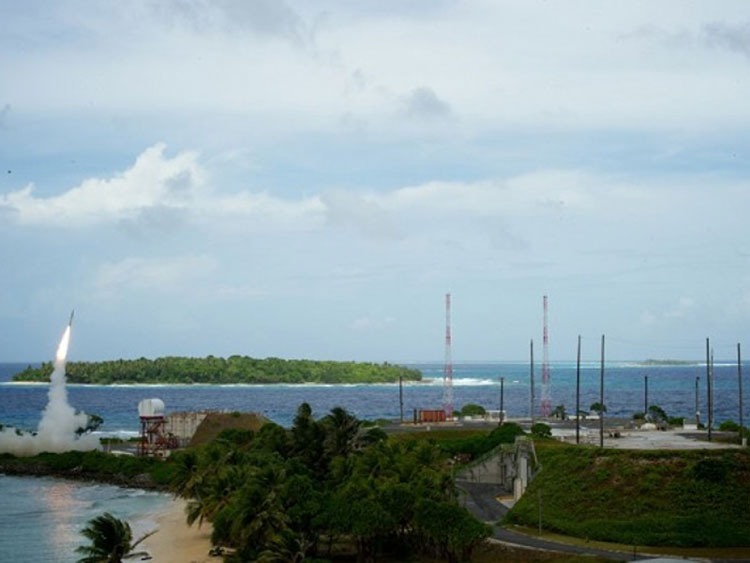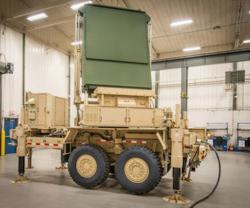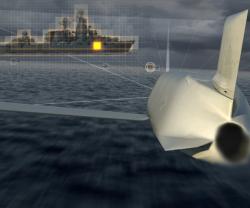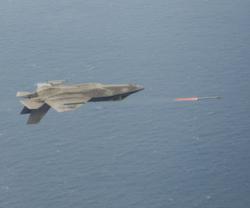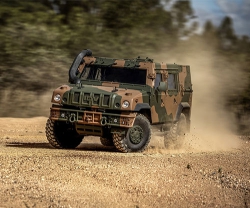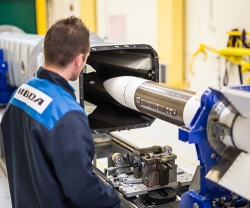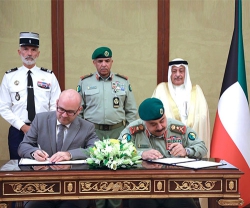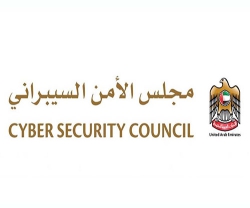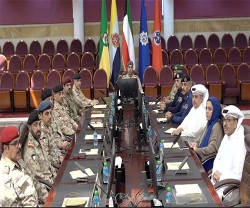Lockheed’s Missile Defense Systems Engage Multiple Targets
29.10.2012 North America
Lockheed Martin's Aegis Ballistic Missile Defense System, Patriot Advanced Capability-3 (PAC-3) Missile and Terminal High-Altitude Area Defense (THAAD) Weapon System successfully engaged in the first-ever test of all three systems demonstrating the integrated capabilities of today's U.S. regional missile defense systems.
These systems worked together to detect, track, engage and negate two ballistic missile targets and one cruise missile-like target during a complex, live-fire flight test conducted by the Missile Defense Agency (MDA) at the Reagan Test Site on the Kwajalein Atoll in the South Pacific.
Known as Flight Test Integrated-01, these different sensors and weapons systems were integrated through the Command and Control, Battle Management, and Communications (C2BMC) system, also developed by Lockheed Martin. The C2BMC is the integrating element for the Ballistic Missile Defense System and links the various sensors and weapon systems.
The flight test began with an Extended Long Range Air Launch Target (E-LRALT) missile airdropped over the broad ocean area north of Wake Island from a U.S. Air Force C-17 aircraft, staged from Joint Base Pearl Harbor-Hickam, Hawaii. The AN/TPY-2 X-band radar, located with the THAAD system on Meck Island, tracked the E-LRALT and a THAAD interceptor successfully intercepted the Medium-Range Ballistic Missile. THAAD was operated by Soldiers from the 32nd AAMDC.
Another short-range ballistic missile was launched from a mobile launch platform located in the broad ocean area northeast of Kwajalein Atoll. The PATRIOT system, manned by soldiers of the 94th AAMDC, detected, tracked and successfully intercepted the target with a PAC-3 interceptor. Additionally, a second PAC-3 interceptor also intercepted a low flying cruise missile target over water.
The USS FITZGERALD (DDG 62) successfully engaged a low flying cruise missile over water. The Aegis system also tracked and launched an SM-3 Block 1A interceptor against a Short-Range Ballistic Missile (SRBM). However, despite indication of a nominal flight of the SM-3 Block 1A interceptor, there was no indication of an intercept of the SRBM.
FTI-01 was a combined developmental and operational test. Soldiers, Sailors, and Airmen from multiple Combatant Commands operated the systems and were provided a unique opportunity to refine operational doctrine and tactics. Program officials continue to assess and evaluate system performance based upon telemetry and other data obtained during the test.
The MDA and the Navy are jointly developing Aegis BMD as part of the United States' Ballistic Missile Defense System. Currently, a total of 30 Aegis BMD-equipped warships - 26 in the U.S. Navy and four in the Japanese Maritime Self-Defense Force - have the certified capability to engage ballistic missiles and perform long-range surveillance and tracking missions. The number of U.S. BMD ships is expected to increase to 32 by 2014.
Since 2006, the THAAD program has successfully completed 12 flight tests, with ten-for-ten intercepts. THAAD and Aegis BMD are the only missile defense systems with the operational flexibility to intercept in both the endo- and exo-atmospheres to provide versatile capability to the Warfighter.
The 'hit-to-kill' PAC-3 Missile is the world's most advanced, capable and powerful theater air defense missile. It defeats the entire threat to the Patriot Air Defense System: tactical ballistic missiles carrying weapons of mass destruction, advanced cruise missiles and aircraft.
Separately, as part of the Kwajalein Range Service (KRS) joint venture, Lockheed Martin employees directed and controlled the radar, telemetry and optics systems on this test at the newly established Ronald Reagan Ballistic Missile Defense Test Site Operations Center in Huntsville. The corporation also recently helped the U.S. Army Space and Missile Defense Command transition testing activities from the U.S. Army Kwajalein Atoll to this operations center, where the first remote missile defense test was controlled and conducted in February. Lockheed Martin supported that milestone with facility selection, design and preparation – and provided hardware and software programs to facilitate these net-centric distributed operations.
Through KRS, Lockheed Martin has supported more than 125 missile defense tests, managing range operations and maintenance on Kwajalein since 2003.
These systems worked together to detect, track, engage and negate two ballistic missile targets and one cruise missile-like target during a complex, live-fire flight test conducted by the Missile Defense Agency (MDA) at the Reagan Test Site on the Kwajalein Atoll in the South Pacific.
Known as Flight Test Integrated-01, these different sensors and weapons systems were integrated through the Command and Control, Battle Management, and Communications (C2BMC) system, also developed by Lockheed Martin. The C2BMC is the integrating element for the Ballistic Missile Defense System and links the various sensors and weapon systems.
The flight test began with an Extended Long Range Air Launch Target (E-LRALT) missile airdropped over the broad ocean area north of Wake Island from a U.S. Air Force C-17 aircraft, staged from Joint Base Pearl Harbor-Hickam, Hawaii. The AN/TPY-2 X-band radar, located with the THAAD system on Meck Island, tracked the E-LRALT and a THAAD interceptor successfully intercepted the Medium-Range Ballistic Missile. THAAD was operated by Soldiers from the 32nd AAMDC.
Another short-range ballistic missile was launched from a mobile launch platform located in the broad ocean area northeast of Kwajalein Atoll. The PATRIOT system, manned by soldiers of the 94th AAMDC, detected, tracked and successfully intercepted the target with a PAC-3 interceptor. Additionally, a second PAC-3 interceptor also intercepted a low flying cruise missile target over water.
The USS FITZGERALD (DDG 62) successfully engaged a low flying cruise missile over water. The Aegis system also tracked and launched an SM-3 Block 1A interceptor against a Short-Range Ballistic Missile (SRBM). However, despite indication of a nominal flight of the SM-3 Block 1A interceptor, there was no indication of an intercept of the SRBM.
FTI-01 was a combined developmental and operational test. Soldiers, Sailors, and Airmen from multiple Combatant Commands operated the systems and were provided a unique opportunity to refine operational doctrine and tactics. Program officials continue to assess and evaluate system performance based upon telemetry and other data obtained during the test.
The MDA and the Navy are jointly developing Aegis BMD as part of the United States' Ballistic Missile Defense System. Currently, a total of 30 Aegis BMD-equipped warships - 26 in the U.S. Navy and four in the Japanese Maritime Self-Defense Force - have the certified capability to engage ballistic missiles and perform long-range surveillance and tracking missions. The number of U.S. BMD ships is expected to increase to 32 by 2014.
Since 2006, the THAAD program has successfully completed 12 flight tests, with ten-for-ten intercepts. THAAD and Aegis BMD are the only missile defense systems with the operational flexibility to intercept in both the endo- and exo-atmospheres to provide versatile capability to the Warfighter.
The 'hit-to-kill' PAC-3 Missile is the world's most advanced, capable and powerful theater air defense missile. It defeats the entire threat to the Patriot Air Defense System: tactical ballistic missiles carrying weapons of mass destruction, advanced cruise missiles and aircraft.
Separately, as part of the Kwajalein Range Service (KRS) joint venture, Lockheed Martin employees directed and controlled the radar, telemetry and optics systems on this test at the newly established Ronald Reagan Ballistic Missile Defense Test Site Operations Center in Huntsville. The corporation also recently helped the U.S. Army Space and Missile Defense Command transition testing activities from the U.S. Army Kwajalein Atoll to this operations center, where the first remote missile defense test was controlled and conducted in February. Lockheed Martin supported that milestone with facility selection, design and preparation – and provided hardware and software programs to facilitate these net-centric distributed operations.
Through KRS, Lockheed Martin has supported more than 125 missile defense tests, managing range operations and maintenance on Kwajalein since 2003.
Latest news
Latest events
DSEI 2025
09 - 12 Sep 2025Excel, London - United KingdomIntersec Saudi Arabia
29 Sep - 01 Oct 2025Riyadh International Exhibition & Convention Centre - Saudi ArabiaDubai International Air Chiefs’ Conference (DIACC 2025)
16 Nov 2025Atlantis, The Palm Dubai - United Arab EmiratesDubai Airshow
17 - 21 Nov 2025Dubai World Central (DWC) - United Arab Emirates

